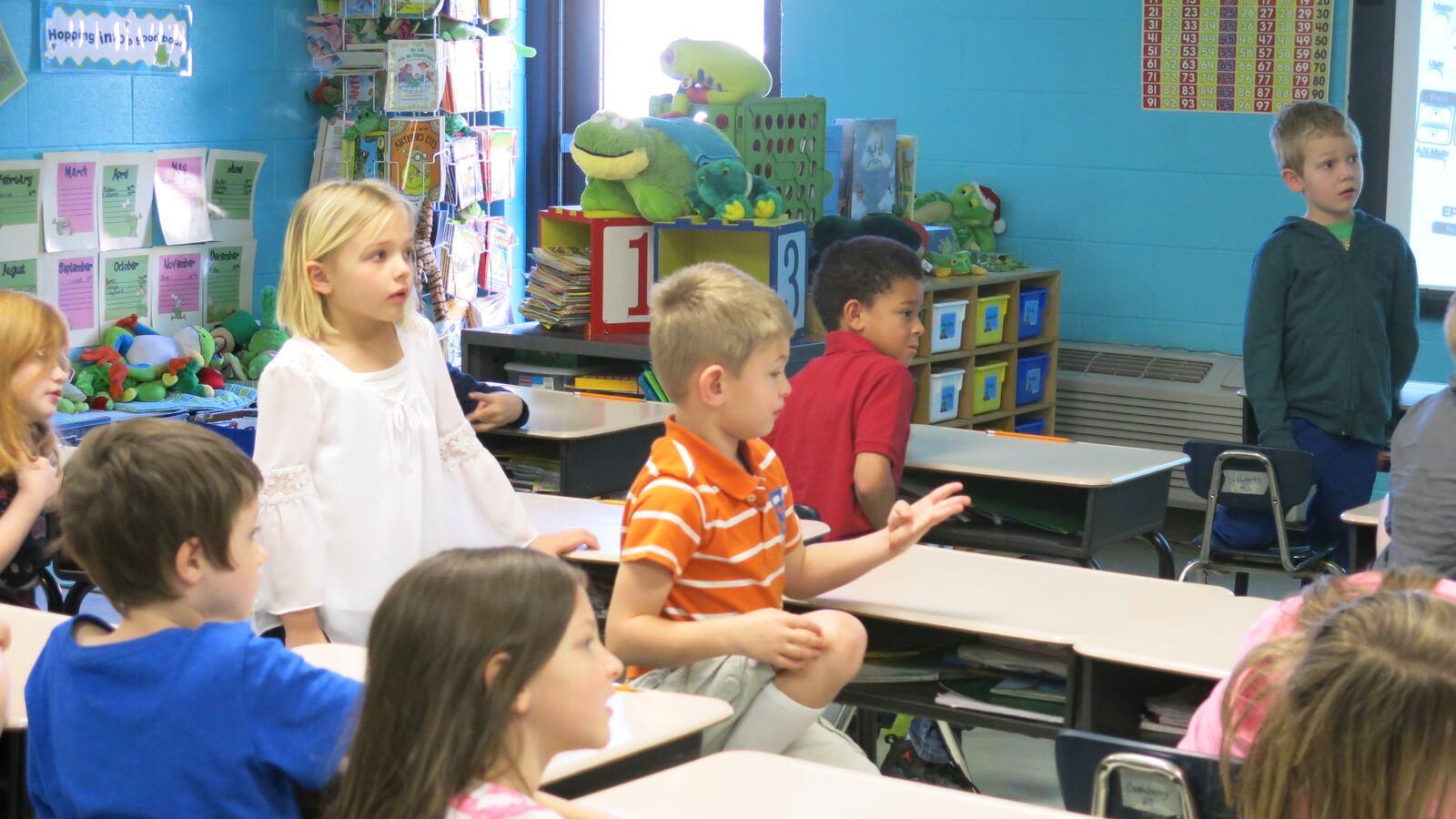In a burst of “mental math,” Cheatham County teacher Amy Castleberry challenges her first-graders to have fun exploring numbers. There are no paper-and-pencil drills, no right or wrong ways. She’s just using a quick free-thinking exercise to inspire each child to figure out how numbers work.
That’s the basis for Number Talks, a 10-to-15-minute conversation about math that elementary schools in her Middle Tennessee district have integrated into their daily routines this school year to complement existing math lessons and curriculum. It’s all to encourage critical thinking skills and a deeper understanding of math concepts under the state’s academic standards.
During one Number Talk this spring, for instance, Castleberry watched her students at Pleasant View Elementary School easily answer a series of single-digit addition problems. Then she introduced a double-digit problem.
“You’re going to show off now — 32 + 14!” she says.
One boy squeals with delight at the challenge as he and the other students begin to think. Some count on their fingers. Others enthusiastically wave their thumbs to signal that they have an answer. Still others sit with furrowed brows. But no one seems anxious. There’s nothing to be graded. The answers are in their heads.
One by one, the children share their answers with the group and how they came up with them — whether by counting up, using an algorithm, or another method of their choosing — as long as they can explain their processes. Their comments reveal how much they understand, and Castleberry interacts with her students to help them sort out the correct answer and which computation methods make the most sense.
Number Talks was developed beginning in the 1990s when two U.S. educators began giving teachers mental math experiences during professional development settings. Impressed with the response, the exercises grew into a mental math format and a toolkit to help children learn math concepts.
America’s students struggle with math. Just one-third of eighth-graders are proficient, according to last year’s National Assessment of Educational Progress. Teachers have long faced challenges to help their students grasp math concepts. Tools such as Number Talks help to bridge the gap in critical computational thinking skills.
Cheatham County math coordinator Joseph Jones learned about Number Talks last year in Nashville during the Tennessee Department of Education’s LEAD conference for district and school leaders. When he went home to research it, he was hooked. This year, he trained his academic coaches to lead mental math exercises, so they could in turn train teachers in grades K-5. He’s also working with middle and high school teachers to weave in the concepts in their classrooms too.
A frequent visitor to classrooms, Jones is constantly surprised by the inventive way students come up with the right answers to math problems. For example, a student recently solved 15 x 35 in his head by multiplying 5 x 35, and then multiplying that by 3, quickly getting the correct answer of 525.
Number Talks don’t dismiss or disavow the algorithms that most teachers and parents learned when they were in school. Algorithms, or a basic set of operations that can be memorized, are still useful. “It’s just we don’t stop there now,” he said.
“Even when (students) don’t remember something, maybe they can think their way to it. That’s honestly at the bottom of it all. What we’re driving at are critical thinking, collaboration … things that go beyond mathematics,” Jones said.
Jones served last year on the panel of Tennessee math educators who reviewed and revised the Common Core math standards. He knows both the state’s current and future math standards well. Number Talks jibe perfectly with them, he says.
“(The talks) allow children to make sense of mathematics in their own thinking, to express themselves, to communicate their reasoning,” he said. “All of that is perfectly in line with the math practice standards.”
Cheatham County teachers are still getting used to the talks, especially since they often involve listening to students detail mathematical mistakes that teachers are eager to correct. But they’re learning to be patient.
"We use numbers every day. ... We've got to be able to have conversations about them."
Susan Collins, academic coach
“Sometimes (students) catch themselves and fix it themselves, and also the other kids around them will give them feedback, especially if they’re wrong,” said Emily Wong, a fourth-grade teacher at East Cheatham Elementary School. “I love watching them learn from each other.”
Teachers learn too, including how to think of math in conversational and conceptual terms. Academic coach Susan Collins, a former English teacher, said the transition was challenging at first but has been rewarding in the end.
“We use numbers every day. … We’ve got to be able to have conversations about them,” she said.

